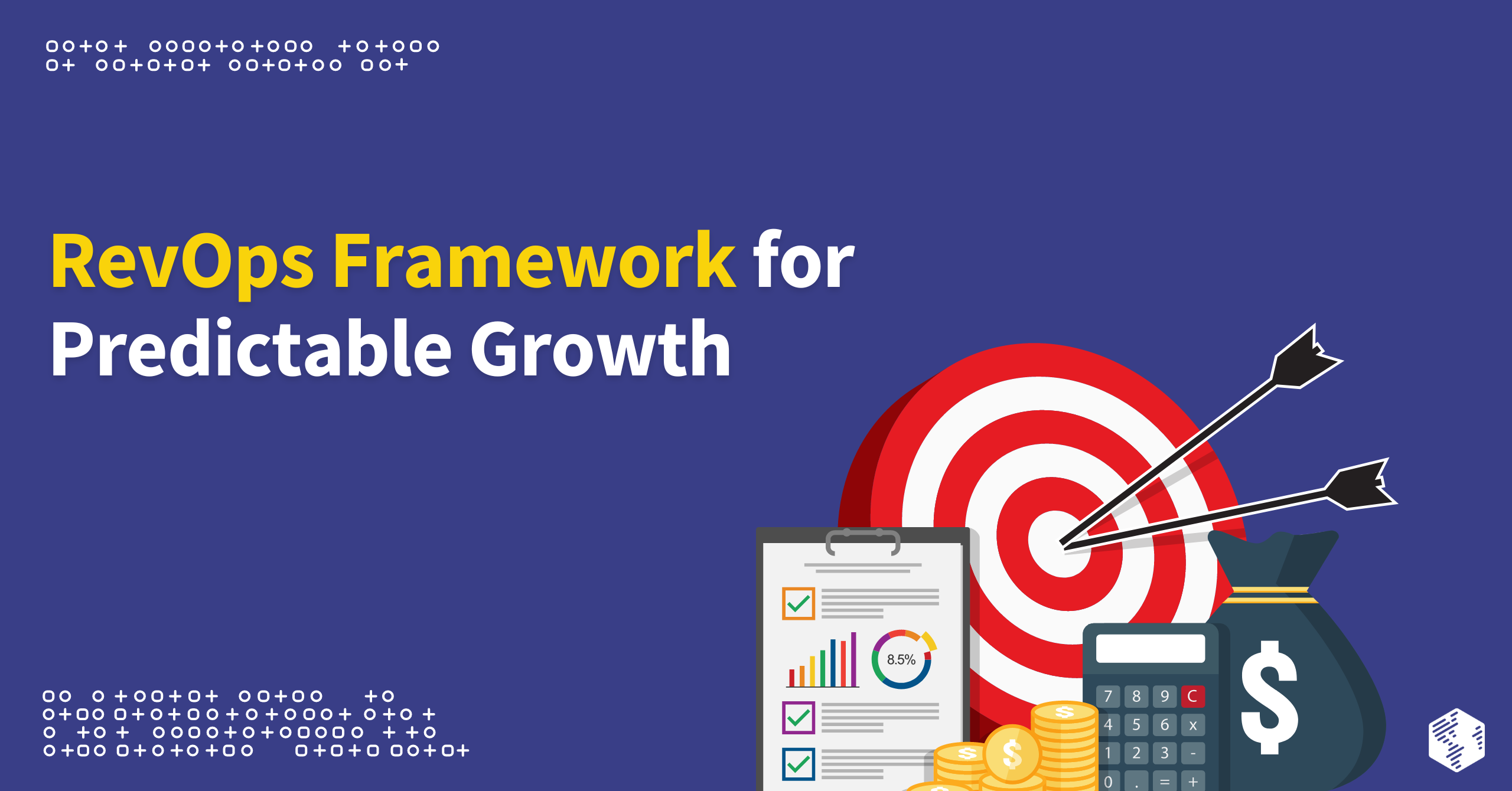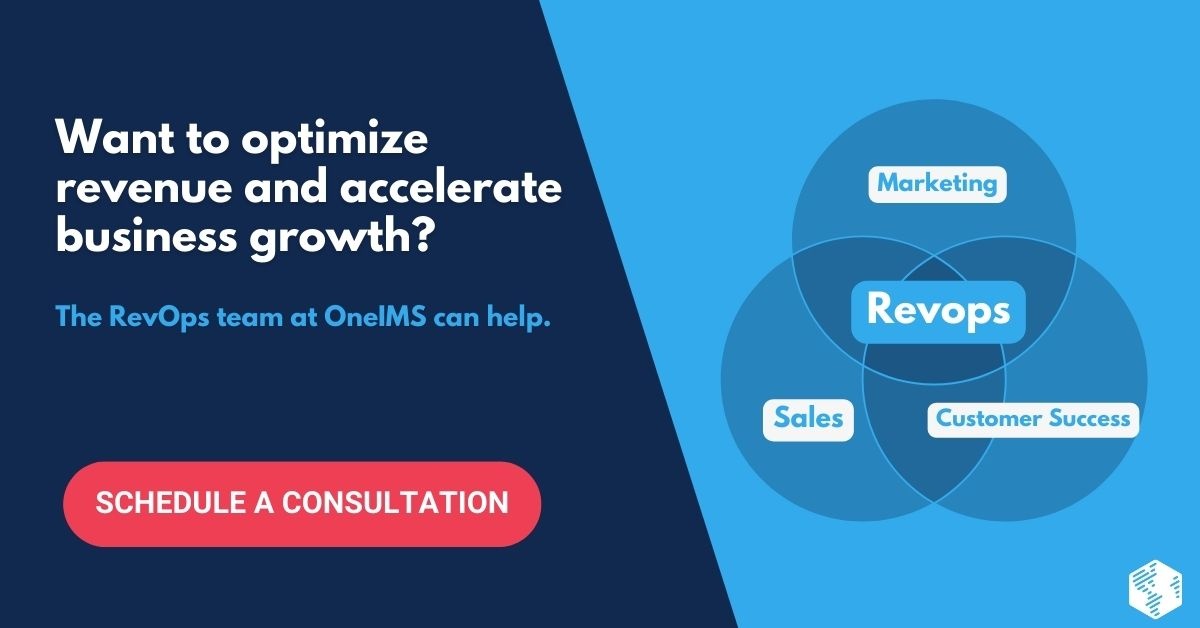Today’s most successful business-to-business (B2B) companies aren’t afraid to change how they operate in order to meet their revenue and growth goals—and if your organization isn’t prepared to optimize your people, processes, and platforms in the name of revenue growth, you’re going to fall behind.
Revenue operations (RevOps) is the key to staying ahead of the competition. The goal of this methodology is to drive business growth and optimize revenue potential by aligning internal teams, consolidating data processes, streamlining platforms and tools, and increasing operational efficiency throughout the entire customer lifecycle.
If you want to drive business growth and boost revenue, you need to create and implement a RevOps framework.
What Is a RevOps Framework?
A framework is a roadmap—a set of processes and actionable steps that a team or department can follow to achieve a set of goals. A revenue operations framework, then, is a plan dedicated to meeting your organization’s overall revenue and growth goals.
RevOps frameworks consist of structures, processes, instructions, and activities that the revenue-generating teams (marketing, sales, and customer success) across your B2B organization can follow. From software and communication to data collection and technology enablement, a revenue operations framework is designed to align and optimize internal operations throughout every stage of the customer lifecycle.
While a RevOps strategy is a set of short-term tasks and actions your team members will take to work toward your revenue goals, a RevOps framework is a long-term, big-picture plan that has room for flexibility based on market trends, business growth, and customer insights.
The Role of a B2B Revenue Operations Framework
B2B companies traditionally face many roadblocks that inhibit revenue growth:
- Inefficient workflows and processes
- Siloed teams
- Unreliable customer data
- Redundant technology platforms
- Wasted time, expertise, and resources
These obstacles make it difficult for organizations to maximize revenue across the customer lifecycle.
Fortunately, a properly implemented revenue operations framework addresses these concerns (and more). With a RevOps framework in place, you can optimize your efforts and support your revenue initiatives:
- Optimized workflows and processes
- Aligned teams
- Reliable, clean, centralized data
- Integrated technology platforms
- Efficient use of time, expertise, and resources
A revenue operations framework is a holistic approach to revenue growth. It breaks down silos among departments, optimizes processes and data collection, and makes it easier to identify opportunities to boost revenue.
If your B2B company wants to operate like clockwork to meet your revenue goals, start by creating and implementing a RevOps framework.
How to Build a RevOps Framework for Predictable Growth
Every business is different. Your B2B company has a unique business model and operating plan, and your revenue goals are one of a kind. That means the revenue operations framework that works best for your organization may not be what works well for another—so just doing what another company does won’t be effective.
Instead, you have to build a revenue operations strategy and framework from the ground up and make sure it is calibrated to your people, processes, and platforms.
The good news is you don’t have to start completely from scratch. An effective revenue operations framework will address several key elements. If you consider the areas in this list, you’ll be well on your way to implementing a successful RevOps strategy.
Alignment & Collaboration
Under a RevOps framework, your revenue-generating teams—marketing, sales, and customer success—are aligned and collaborate in order to achieve your revenue goals.
Marketing & Sales Alignment
Sales and marketing teams need to collaborate on all revenue-generating activities. By working toward shared revenue goals, regularly communicating across departments, and using an integrated technology stack, these teams can enable each other to be more efficient than ever.
For example, when marketing and sales teams are misaligned, so is customer communication. While marketing says one thing in content on social media or in an email newsletter, sales representatives may tell a different story. By bringing these teams into alignment, they can improve this messaging to make it consistent and effective.
Sales & Customer Success Alignment
Customer success has a significant impact on the success of your sales team’s efforts, and vice versa. Aligning these teams under the same revenue goals ensures your organization makes the most out of each and every sales opportunity.
When customer success encourages customers to share testimonials and reviews, sales reps can use those insights to inspire prospects to make a purchase. If sales records data throughout all interactions with a prospect, customer success can use insights from that data to ensure the customer has a positive experience.
Creating a unified, aligned strategy between the sales and customer success teams can lead to long-term success and increased revenue.
Data Integration & Analysis
RevOps is driven by data. That means your revenue operations team as well as your marketing, sales, and customer success teams need access to accurate, reliable data so they can make data-driven decisions that support your revenue goals.
Data Collection & Centralization
Your marketing, sales, and customer success teams can’t make data-driven decisions without access to reliable data in a centralized location. Unfortunately, if people across your B2B company are individually keeping track of customer interactions, or if your customer-facing teams have their own siloed data collection processes, it can lead to lost or inaccurate customer information.
Instead, establish data collection workflows, ensure those workflows are followed by all departments, and store the results in a centralized location so everyone can find and retrieve the accurate, consistent data they need.
Data Analysis & Insights
Revenue operations relies on data. The analysis of customer data and the resulting insights drives informed decision-making across your customer-facing teams and shapes successful strategies throughout the customer lifecycle.
With the insights gained by data analysis, you can optimize workflows and create processes designed to increase productivity, efficiency, and revenue.
Process Optimization
A revenue operations framework simplifies and optimizes processes across the customer lifecycle. With this model in place, your revenue-generating teams can work more efficiently, follow best practices, and optimize their efforts.
Marketing Process Optimization
From campaign tracking and lead nurturing to marketing automation and content development, marketing processes are intended to attract the attention of your target audience and nurture leads until they are ready to become prospects.
With so many working parts, there are lots of ways these processes can be inefficient or have gaps that hinder revenue growth. Identifying, documenting, and optimizing marketing processes is an important part of ensuring your marketing team has the workflows and action plans it needs to work toward your revenue goals.
Sales Process Optimization
Lengthy sales cycles, high churn rates, inefficient workflows, and mismatched priorities make it difficult for your sales representatives to successfully convert prospects into customers at scale. By optimizing your sales team’s processes—speeding up the sales cycle, reducing the churn rate, automating workflows, and scoring leads—you can build and maintain a healthy, robust, revenue-generating sales pipeline.
Customer Success Process Optimization
When customers are treated well and have a positive experience with your B2B company, they are more likely to become loyal customers—leading to an increased customer lifetime value (CLV or LTV) and projected revenue.
Optimizing every piece of the customer success puzzle, from the new customer onboarding process to the process for addressing customer feedback, is essential to long-term growth.
Technology Enablement
The right RevOps platforms, tools, and software can enable your teams to be more efficient and make it easier for them to achieve your revenue goals.
CRM & Marketing Automation
Customer relationship management (CRM) tools help you manage customer data and interactions across the entire customer lifecycle. Marketing, sales, and customer success teams can use a CRM platform to access, organize, and analyze data. Armed with reliable and centralized data, your customer-facing teams can improve communication with customers and make each interaction personal—leading to increased customer satisfaction and revenue growth.
Marketing automation software also allows your team members to focus on value-added work instead of dedicating time to routine, redundant tasks. This type of tool is an essential part of optimizing workflows and processes.
Revenue Operations Platforms
RevOps platforms are designed to manage company-wide revenue operations from end to end. This type of software centralizes data and provides insights across the customer lifecycle, working as a single source of information for your customer-facing teams. Use revenue operations platforms to make more accurate sales forecasts, gain valuable market data, automate RevOps processes, and understand customer satisfaction.
Measurement & Continuous Improvement
How do you know if your RevOps strategy is making a difference? How can you tell what’s working (and what isn’t)? How can you improve your revenue operations framework to boost organizational growth?
Your revenue operations framework is not set in stone. To operate at peak efficiency and successfully achieve your revenue goals, your organization must continuously measure revenue-based key performance indicators (KPIs), evaluate the effectiveness of your RevOps framework, and make improvements to your revenue strategy from top to bottom.
Partner with OneIMS to Create a Growth-Focused RevOps Framework
It’s time for your B2B company to create a RevOps framework to ensure you are consistently meeting your revenue goals and growing at scale.
At OneIMS, our team of RevOps experts is ready to help your organization design and implement a revenue operations framework that maximizes your growth potential and transforms your business into a revenue-generating machine. We have a long history of working with companies in a variety of industries to develop innovative and data-driven marketing solutions, and we pride ourselves on producing measurable and sustainable results that lead to long-term growth.
But you don’t have to take our word for it. View testimonials from our clients and read our blog to get an idea of our training, experience, and track record of success.
Are you ready to meet your revenue goals and prioritize growth? Schedule a consultation with us today to get started.

































